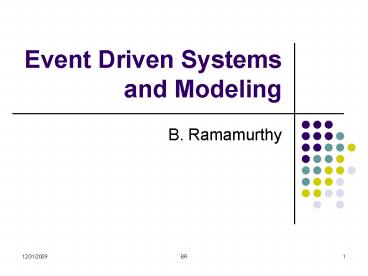Event Driven Systems and Modeling - PowerPoint PPT Presentation
Title:
Event Driven Systems and Modeling
Description:
... to handle just one event. 11/8/09. BR. 9. Designing Custom Events ... However, by convention, each method normally takes only one argument: the event. 11/8/09 ... – PowerPoint PPT presentation
Number of Views:68
Avg rating:3.0/5.0
Title: Event Driven Systems and Modeling
1
Event Driven Systems and Modeling
- B. Ramamurthy
2
Topics
- Simple Event cycle
- Source, target, activation, dispatch, listener,
handler - Example SimpleExample.java that comes JDK
distribution. - Custom events
- Event driven systems
3
Types of Programs
- Control-driven The order in the program code
determines the sequence of events. - The actions are predetermined.
- Event-driven The operation of the program
depends on what you do with the controls
presented (usually by the GUI) - Selecting menu items, pressing buttons, dialog
interaction cause actions within the program. - Events in dynamic system/asynchronous systems.
4
Events
- 1. Actions such as clicking a button, moving a
mouse, are recognized and identified by the
operating systems(OS) or JVM. - 2. For each action, OS/JVM determines which of
the many currently running programs should
receive the signal (of the action) - 3. The signals that the application receives from
the OS/JVM as result of the actions are called
events.
5
Event Generation
User Interface
Mouse actions, keystrokes, events
Operating Systems
JAVA API /Windows
Events
Methods and handlers
Methods and handlers
Application 1
Application 2
6
Event Handlers
- An application responds to the events by
executing particular code meant for each type of
event. - Not all events need to be handled by an
application. For example, a drawing application
may be interested in handling only mouse
movements. - As a designer of an event-driven application you
will write classes/methods to handle the relevant
events.
7
Event Handling Process
- Source of an event is modeled as an object. Ex
button clicks object is a button - Type of the event ActionEvent, WindowEvent,
MouseEvent etc. Ex An ActionEvent object is
passed to the application that contains
information about the action. - Target of an event Listener object of the event.
Passing the event to a listener results in
calling a particular method of the listener
object.
8
Event Handling
- Three ways
- Application/applet itself is a (mouse) listener,
with an action performed method. - Event handling delegated to an object specially
instantiated for this purpose. - Anonymous class/object to handle just one event.
9
Designing Custom Events
- Three elements to generate and listen to events
- An event class
- An event listener interface
- An event generator
10
Event class
- Java provides two super classes to define event
class - EventObject (for non-GUI events)
- AWTEvent (typically for GUI controls)
- EventObject has at least one method getSource
that returns an Object at which the event
occurred. - For your custom event class you extend this class
and add other methods needed.
11
Listener Interface
- The listener interface provides the contract
between the listeners and the event generator. - The contract provides the event generator with
the method to call when it fires an event. - When creating an event listener interface, you
can add as many methods as you need. - However, by convention, each method normally
takes only one argument the event.
12
Event Generator
- An event generator tracks listeners, provides a
mechanism to add and remove listeners, and, at
the appropriate time, fires events to the
listeners. - When creating an event generator, make sure its
registration mechanism is thread safe. - Generator receives the stimulus and dispatches
the events. - Lets look at Mr. Happy Object example.
13
Event Mood
- Write the Mood class
- Write the MoodEvent class that extends
EventObject - Write MoodListener that has one method
MoodReceived - Mr.HappyObject will allow registration of
listeners (add and remove listeners) and receive
stimulus of pinch and hug and dispatch them
appropriately. - Listener classes (Sky and FlockOfBirds) implement
MoodListener interface. - These listeners are added to HappyObject by the
application. - They keep listening to HappyObject mood change
and take appropriate action.
14
UML diagram
15
Summary
- Apply the concept studied to an event driven
system. - Design events, event object classes, listener
interfaces, event generators-registrars and
dispatchers. - And an application connecting all these.

